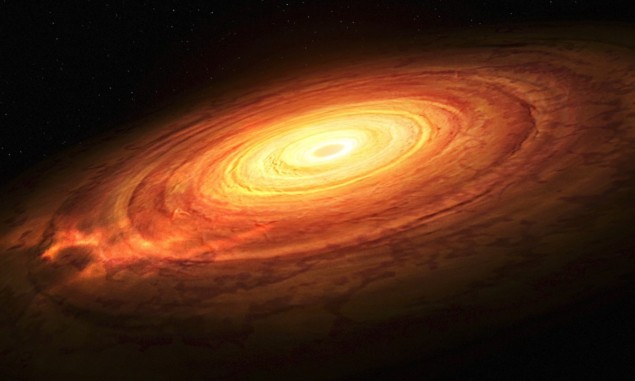
A correlation between the masses of supermassive black holes (SMBHs) and the timings of fluctuations in the brightness of their accretion discs has been found by astronomers in the US and the UK. Colin Burke at the University of Illinois at Urbana-Champaign and colleagues believe that their discovery could help astronomers to better determine the masses of smaller supermassive black holes. Their research also hints at an emission mechanism that could be universal across many different types of accretion disc.
Accretion discs of gas, dust, and plasma surround SMBHs, which dominate the centres of many galaxies – including the Milky Way. As material from the disc falls into a SMBH, it is rapidly compressed and heated. This causes it to emit vast amounts of radiation at optical and ultraviolet wavelengths. These emitting discs are called active galactic nuclei (AGN) and can sometimes outshine all the stars in their galaxy. Optical emissions from these discs undergo seemingly random fluctuations in intensity, which can vary over a wide range of timescales. So far, the mechanisms underlying this flickering behaviour have remained a mystery.
To investigate the process in more detail, the team studied previous observations of 67 AGN, spanning the entire mass range of known SMBHs: from 10,000 to 10 billion solar masses. After measuring fluctuations in the optical emissions of each object, the researchers used a “damped random walk” model to determine the timescales over which these variations became noticeably smaller – or dampened. Across the entire range they studied, the astronomers spotted a correlation between the timescales of emission variability, and SMBH masses.
Mysterious mechanisms
Although the physical mechanisms driving these fluctuations remain a mystery, Burke’s team speculate that the damping timescales could closely trace fluctuation timescales in the heat emitted by the inner part of the accretion disc. Regardless of the cause, the researchers propose that the correlation they uncovered could be used to estimate the masses of SMBHs, simply by observing the variability of AGN associated with them.

Have pulsars provided a glimpse of gravitational waves from merging supermassive black holes?
This technique would be particularly useful when studying smaller SMBHs with AGN emissions that can be too weak for astronomers to make more robust measurements. In addition, it could help astronomers to place tighter constraints on the dynamic processes taking place within the inner regions of SMBH accretion discs.
Furthermore, Burke and colleagues noticed that similar correlations can be found between the masses and emission variability timescales of white dwarf accretion discs – which emit radiation through similar mechanisms as AGN. This suggests that a common process could be shared by all accretion discs – which can also be found surrounding objects including protostars, planets, and neutron stars. Through further analysis, the team now hope to explore this possibility in more detail.
The research is described in Science .



